Related Research Articles
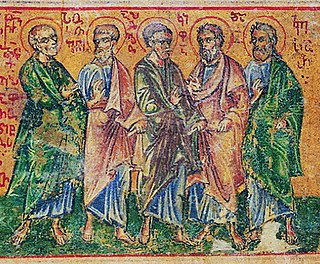
Apollos was a 1st-century Alexandrian Jewish Christian mentioned several times in the New Testament. A contemporary and colleague of Paul the Apostle, he played an important role in the early development of the churches of Ephesus and Corinth.

Ephesus was a city in Ancient Greece on the coast of Ionia, 3 kilometres (1.9 mi) southwest of present-day Selçuk in İzmir Province, Turkey. It was built in the 10th century BC on the site of Apasa, the former Arzawan capital, by Attic and Ionian Greek colonists. During the Classical Greek era, it was one of twelve cities that were members of the Ionian League. The city came under the control of the Roman Republic in 129 BC.
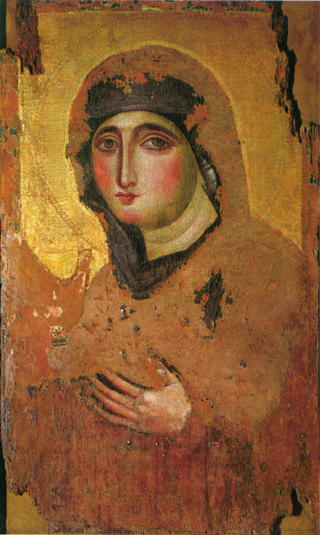
Mary was a first-century Jewish woman of Nazareth, the wife of Joseph and the mother of Jesus. She is a central figure of Christianity, venerated under various titles such as virgin or queen, many of them mentioned in the Litany of Loreto. The Eastern and Oriental Orthodox, Church of the East, Catholic, Anglican, and Lutheran churches believe that Mary, as mother of Jesus, is the Mother of God. Other Protestant views on Mary vary, with some holding her to have considerably lesser status.

Gennadius II was a Byzantine Greek philosopher and theologian, and Ecumenical Patriarch of Constantinople from 1454 to 1464. He was a strong advocate for the use of Aristotelian philosophy in the Orthodox Church.
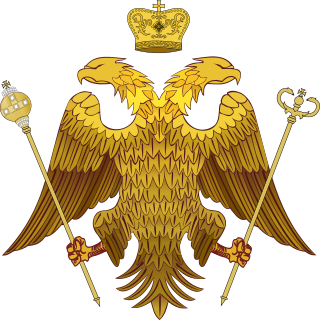
The Church of Cyprus is one of the autocephalous Greek Orthodox churches that together with other Eastern Orthodox churches form the communion of the Eastern Orthodox Church. It is one of the oldest Eastern Orthodox autocephalous churches; it claims to have always been independent, although it may have been subject to the Church of Antioch before its autocephaly was recognized in 431 at the Council of Ephesus. The bishop of the ancient capital, Salamis was constituted metropolitan by Emperor Zeno, with the title archbishop.

Proclus was the archbishop of Constantinople from 434 until his death. Renowned for his homiletic abilities, Proclus played a central role in the Nestorian controversy. His contributions to the theology of the developing cult of the Virgin Mary place him among the early and foremost Marian theologians. He is venerated as a saint in the Catholic Church, the Eastern Catholic Churches, the Eastern Orthodox Church, and Oriental Orthodoxy.

The Dormition of the Mother of God is a Great Feast of the Eastern Orthodox, Oriental Orthodox, and Eastern Catholic Churches. It celebrates the "falling asleep" (death) of Mary the Theotokos, and her being taken up into heaven. It is celebrated on 15 August as the Feast of the Dormition of the Mother of God. The Armenian Apostolic Church celebrates the Dormition not on a fixed date, but on the Sunday nearest 15 August. In Western Churches the corresponding feast is known as the Assumption of Mary, with the exception of the Scottish Episcopal Church, which has traditionally celebrated the Falling Asleep of the Blessed Virgin Mary on 15 August.
John of Ephesus was a leader of the early Syriac Orthodox Church in the sixth century and one of the earliest and the most important historians to write in Syriac. John of Ephesus was a bishop, but John was more important than other bishops and what sets him apart from most others is the fact that he was a historian and a writer. He was also a political man and would often follow his own path. John was seen as a great writer and covered important aspects of events in history, and one of these important events was the plague, and John has one of the only first-hand accounts of the plague. He was also alive in what has been called the worst year in history, 536.
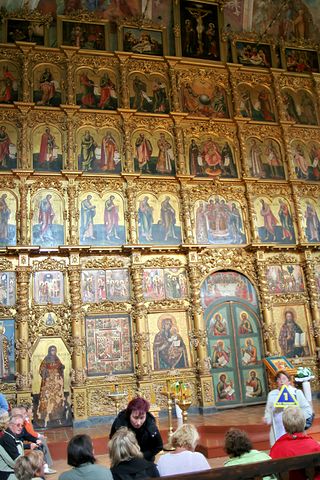
The Byzantine Rite, also known as the Greek Rite or the Rite of Constantinople, is a liturgical rite that is identified with the wide range of cultural, devotional, and canonical practices that developed in the Eastern Christian Church of Constantinople.
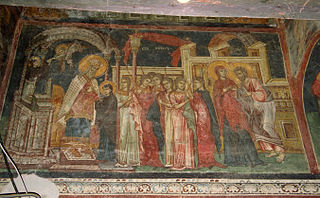
The Presentation of the Blessed Virgin Mary, known in the East as The Entry of the Most Holy Theotokos into the Temple, is a liturgical feast celebrated on November 21 by the Catholic, Eastern Orthodox, and some Anglo-Catholic Churches.

Mark of Ephesus was a hesychast theologian of the late Palaiologan period of the Byzantine Empire who became famous for his rejection of the Council of Ferrara-Florence (1438–1439). As a monk in Constantinople, Mark was a prolific hymnographer and a follower of Gregory Palamas theological views. As a theologian and a scholar, he was instrumental in the preparations for the Council of Ferrara-Florence, and as Metropolitan of Ephesus and delegate for the Patriarch of Alexandria, he was one of the most important voices at the synod. After renouncing the council as a lost cause, Mark became the leader of the Orthodox opposition to the Union of Florence, thus sealing his reputation as a defender of Eastern Orthodoxy and pillar of the Eastern Orthodox Church.

The Nativity of the Blessed Virgin Mary, the Nativity of Mary, the Marymas or the Birth of the Virgin Mary, refers to a Christian feast day celebrating the birth of Mary, mother of Jesus.
In Christianity, the Nativity Fast—or Fast of the Prophets in Ethiopian Orthodox Tewahedo Church and Eritrean Orthodox Tewahedo Church—is a period of abstinence and penance practiced by the Eastern Orthodox Church, Oriental Orthodox Church and Catholic Church in preparation for the Nativity of Jesus on December 25. Ethiopian and Eritrean Orthodox Churches commence the season on November 24th and end the season on the day of Ethiopian Christmas which falls on 7th of January. The corresponding Western season of preparation for Christmas, which also has been called the Nativity Fast and St. Martin's Lent, has taken the name of Advent. The Eastern fast runs for 40 days instead of four or six weeks and thematically focuses on proclamation and glorification of the Incarnation of God, whereas the Western Advent focuses on three comings of Jesus Christ: his birth, reception of his grace by the faithful, and his Second Coming or Parousia.

Antiochene Rite or Antiochian Rite refers to the family of liturgies originally used by the Patriarchate of Antioch.
The Lity or Litiyá is a festive religious procession, followed by intercessions, which augments great vespers in the Eastern Orthodox and Byzantine Catholic churches on important feast days. Following a lity is another liturgical action, an artoklasia, and either of these terms may be used to describe both liturgical actions collectively.
Arsenios Autoreianos, , Ecumenical Patriarch of Constantinople, lived about the middle of the 13th century.
The Metropolis of Ephesus was an ecclesiastical territory (metropolis) of the Ecumenical Patriarchate of Constantinople in western Asia Minor, modern Turkey. Christianity was introduced already in the city of Ephesus in the 1st century AD by Paul the Apostle. The local Christian community comprised one of the seven churches of Asia mentioned at the Book of Revelation, written by John the Apostle. The metropolis remained active until 1922-1923.
This is a timeline of the presence of Eastern Orthodoxy in Greece from 717 to 1204. The history of Greece traditionally encompasses the study of the Greek people, the areas they ruled historically, as well as the territory now composing the modern state of Greece.

Saint Gregory of Dekapolis or Gregory Dekapolites was a 9th-century Byzantine monk, notable for his miracle-working and his travels across the Byzantine world. He is known as "the New Miracle-Worker", and his feast day in the Eastern Orthodox Church and Roman Catholic Church is on November 20.
References
- ↑ "Abraham Of Ephesus, St".
- ↑ B. L. Marthaler (2003). New Catholic encyclopedia. Catholic University of America (2nd ed.). Detroit: Thomson/Gale. p. 38. ISBN 0-7876-4004-2. OCLC 50723247.